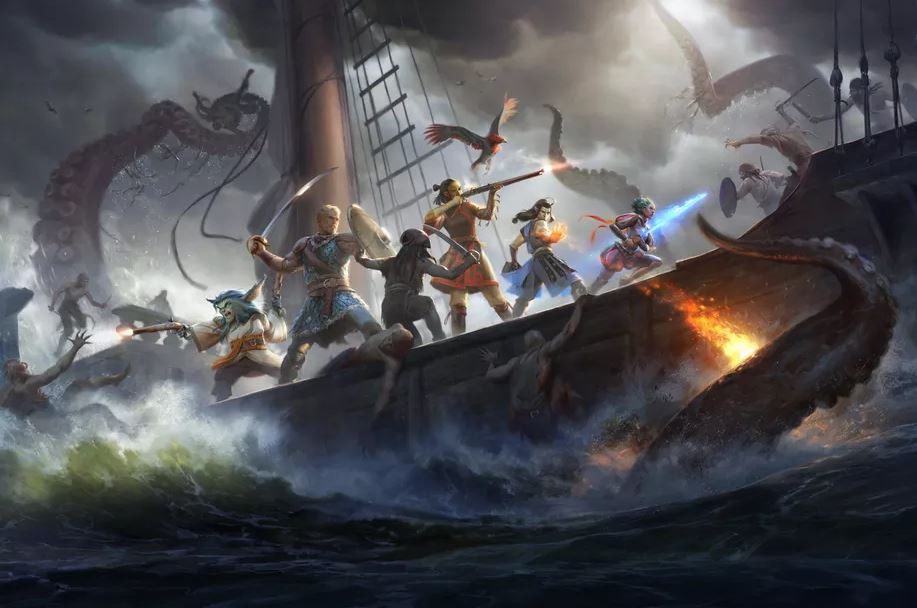almondblight
Arcane
- Joined
- Aug 10, 2004
- Messages
- 2,549
So...the Paradise Lost: First Contact demo is out. Which is nice, considering the game looked like it might be dead a little while ago.




$1 Canadian to get the game. A "weekend jam" type special, though he's actually been working on it a couple months. Fantasy adventure all about choice and consequence.















Hi,
I was wondering if you'd be interested in writing an article about Fracture Fall [PC game].
https://www.indiegogo.com/projects/fracture-fall-rpg-adventure#/
I understand if you don't do coverage of crowdfunding campaigns, but I was hoping you'd take a look at my project. I'm a tabletop RPG'er and this is my take on the choices in games.
It's a kind of genre combination. Think of Pirates and King of Dragon Pass in space, and the atmospheric Sunless Sea.
It's pretty much as indie as it gets (I've been developing it on my own for two years now with my own money) and now I'm having bit of a hard time reaching my audience, especially in the US.
There is a lot of info available on the site, but there is a lot I couldn't fit into a crowdfunding page. If you want an angle, please contact me and ask away!
Anyway, hope the new years is treating you well!
-Turkka
twotalesgames.com








Apocalypse Now isn't picking up the crazy momentum that I thought it would, even after a big media push. It's a shame because it does seem interesting but it seems like a game that will actually need much more money than they're asking for

Big shame.
























Crowdfunding for video games was way down in 2016
Fig and Gambitious didn’t cover Kickstarter’s decline, and tabletop is still booming
Crowdfunding revenues for video game projects appear to have fallen in 2016. The decline is especially large on Kickstarter, where the revenue earned by successful projects was down nearly 60 percent.
This year was the first time since its founding in 2009 that the crowdfunding giant took in less money — roughly 5.8 percent less overall — than the year before. That makes the precipitous decline of the video game category all the more unusual.
So where did the money go? For our analysis, Polygon solicited data from all four of the major video game crowdfunding platforms — Fig, Gambitious, IndieGoGo and Kickstarter — in early December. Only IndieGoGo failed to respond to our request by the end of January. Using that data, we’ve uncovered a picture of an industry in transition, and on the cusp of what promises to be a fascinating New Year.
KICKSTARTER NO LONGER DOMINANT
The biggest finding was the marked decline in the revenue earned by successful video game projects on Kickstarter.
In 2015, successful video game Kickstarters earned a total of $41.5 million. In 2016 however, successful campaigns earned at most* $17.6 million. That represents a roughly 60 percent decline in revenue for the category.
That 60 percent decline can be applied on a per project basis as well.
There were basically the same number of successful campaigns in 2016 (388) as in 2015 (374). So a successful campaign in 2016 would have averaged $45,360, versus an average of $110,962 in 2015.
While in 2015 tabletop games earned twice as much money as video games, in 2016 they earned nearly six times more. That figure confirms a trend uncovered by ICO partners over the summer.
The tabletop category increased by nearly 20 percent from 2015, growing the amount of revenue raised by successful campaigns from $84.6 million to at most* $101.2 million. The number of successful campaigns was also up by nearly 23 percent.
THE GROWTH OF EQUITY CROWDFUNDING
Fig was a disruptive force last year, entering the crowdfunding space with a combination of traditional rewards-based options as well as equity investment. But it also pulled several major players out of the Kickstarter ecosystem.
DoubleFine and InXile have both run successful, multi-million dollar campaigns on Kickstarter in years past. In 2016, they took their business to Fig. Even though that company endured an extended period of review by the U.S. Securities and Exchange Commission that dragged on for months, they made an impressive showing. DoubleFine’s campaign for Psychonauts 2 raised over $3.8 million, while InXile’s Wasteland 3 raised over $3.1 million.
Add to that several smaller projects, and we find that Fig raised more than $7.8 million — nearly half of what Kickstarter did — in its first full year.
Also sharing its numbers with Polygon for the first time this year is Gambitious, which describes itself as a “hybrid crowd finance platform and indie publishing label.” Founded in 2012, they are the first gaming crowd finance platform to actually turn a profit for its investors. But, more importantly for our analysis, they also grew their business and collected nearly $2.6 million dollars of investment.
But even when you add together the money earned by Fig and Gambitious, it doesn’t equal the amount of revenue that Kickstarter declined in 2016. Our figures show that crowdfunding for video games was down roughly $13.5 million last year, or around 33 percent.
Again, the large caveat here is that IndieGoGo, which did not share numbers with Polygon, could have had an impressive year.
SO WHERE DID THE MONEY GO?
While it’s true that Kickstarter itself finished down overall in 2016, the decline in the video game category was remarkable. But it’s difficult to say where a third of 2015’s video game crowdfunding money went. Three possibilities come to mind.
First, some consumers could have lost their appetite for crowdfunding video games entirely. The long development times inherent to the video game industry, as well as some high-profile projects that have failed to deliver on their promises, could have soured them on crowdfunding in general.
Second, it is now hard to ignore the fact that the incredible growth of tabletop could be stealing away a portion of the revenue consumers previously used to crowdfund video games. Without much more granular data from Kickstarter, it’s hard to provide a good case for this however. Anecdotally, people who enjoy video games also seem to be big fans of board games, and they’re not shy about spending a lot of money on physical products. But there’s no real way to track where they spend their crowdfunding money.
Third, Fig’s months-long delay getting approval from the SEC could have simply pushed a number of large projects into 2017 that would have otherwise been on the books in 2016. Pillars of Eternity 2: Deadfire is already off to an amazing start with more than $2 million raised in a matter of weeks. A few more campaigns like that, and the $13.5 million deficit might quickly evaporate.
Whatever the case, it’s clear that equity crowdfunding options, like Fig and Gambitious, are here to stay. It will be interesting to see which independent developers warm up to the model.
How things play out in 2017 will be very interesting.
This year was the first time since its founding in 2009 that the crowdfunding giant took in less money — roughly 5.8 percent less overall — than the year before. That makes the precipitous decline of the video game category all the more unusual.
The anticipated amount that Fig will directly fund the developer for the development of the game, from its working capital funded in part by the investment proceeds.















As Kickstarter matures, crowdfunded games find safety in sequels and big names
Wasteland 3
If you take a look at the “most funded games” section of Kickstarter, one major trend becomes immediately clear. You’ll spot a number of spiritual successors, games meant to evoke (and made by many of the same developers as) classics like Castlevania, Mega Man, and Banjo-Kazooie. If a game isn’t a spiritual successor, it’s a direct one, with sequels to cult classics like Shenmue, Wasteland, and Elite filling out the list.
During the initial boon of crowdfunding, the platform was seen by many as a lifeline for tiny studios making weird or risky new games. But as the market has evolved and matured, so too have the games that manage to raise a lot of cash. While smaller indie titles can still do well on Kickstarter and other crowdfunding platforms, the biggest success stories are titles that sit somewhere in between tiny indie teams and massive blockbusters. Once prevalent, these mid-level games have slowly died out as publishers shifted resources to lucrative free-to-play games and near-sure-thing AAA titles.
For the developers of these games, crowdfunding has proved to be the only real option. Brian Fargo, CEO of Wasteland 2 studio Inxile, explains that crowdfunding “has allowed us to raise millions of dollars to make games that would have never existed. I say that confidently because I tried for years using the traditional routes.”
Inxile is one of the studios leading this charge. In 2012, not long after the breakout success of Double Fine’s Broken Age campaign, Fargo and Inxile attempted to crowdfund a sequel to the 1988 post-apocalyptic role-playing game Wasteland. (Fargo served as director on the original game, as well as producer on similar titles like first Fallout.) The Kickstarter went on to raise $2.9 million, and changed the studio’s trajectory.
/cdn0.vox-cdn.com/uploads/chorus_asset/file/7995919/pillars_deadifre_desert_temple.png)
Pillars of Eternity II
Founded in 2002, Inxile had previously worked on games for publishers like Ubisoft and Bethesda. In some instances, like the Codemasters-published Heist, the studio’s games were canceled and never released. Crowdfunding provided a different route. It was an opportunity to make the games the studio wanted to without being beholden to a publisher.
“The biggest difference in working with our audience [and not a publisher] is the trust factor,” Fargo explains. “They give us the money upfront to bring to life the vision that we pitched to them. We can be more flexible in our development, allowing us to jettison things that don't make sense anymore and give greater focus to the parts that feel good. Publisher's often overly rely on the contract milestones and can force you to walk a path that doesn't make sense in the changing environment of development.”
All of the titles Inxile has worked on since have utilized crowdfunding to some degree. It followed Wasteland 2 with the old-school-style RPG Torment: Tides of Numenera, which went on to became Kickstarter’s third most-funded game raising more than $4 million. More recently, the studio made its debut on the game-focused crowdfunding service Fig to raise $3.1 million for a third Wasteland game.
Titles like Koji Igarashi’s Bloodstained: Ritual of the Night, Obsidian Entertainment’s Pillars of Eternity, and Playtonic Games’ Yooka-Laylee did much the same, combining experienced developers with a well-known and beloved style of game. As Kickstarter has matured, and many projects unfortunately proved to be disappointments, these factors have become increasingly important. The top 10 most funded games on the platform are all either a direct sequel to a classic game, or some form of spiritual successor. “I think that backers are more discerning now, since unfortunately a number of crowdfunded games did not come out, or did not deliver on all of their promises,” says Obsidian CEO Feargus Urquhart. Obsidian is currently crowdfunding a sequel to fantasy RPG Pillars of Eternity, and has more than doubled its initial $1.1 million goal.
Backers are becoming more wary of where they put their money, and the comfort of a successful studio and a familiar game means a higher likelihood of funding. In fact, prior crowdfunding success has become a big draw, with studios like Inxile and Obsidian able to consistently fund new projects because they’ve already proven they can fulfill campaign promises. “The initial excitement of throwing money at almost every new project has dampened the hype, leaving us with a more cautious group of backers who are looking carefully at the teams and the details,” Fargo says. “Clearly there is still interest and our audience has continued to be super supportive.”
This is true even for projects that aren’t looking for millions of dollars. Failbetter Games earned itself something of a cult following with the long-running text-based virtual world Fallen London. The team wanted to expand the world with a new title, but a gothic survival game set in a hellish sea filled with cannibals and monsters isn’t exactly the kind of game that publishers flock to. So the studio took to Kickstarter instead. “Fallen London was barely keeping us afloat,” explains Failbetter communications director Hannah Flynn. “It was really the last roll of the dice.”
/cdn0.vox-cdn.com/uploads/chorus_asset/file/7995967/ss_1bbcfe9a22c7bb66403381cc5a58d58ce5037caf.jpg)
Sunless Sea
The game, called Sunless Sea, went on to raise more than £100,000 (about $125,000) in 2013. Earlier this month a sequel, dubbed Sunless Skies, topped that by raising nearly £260,000 (about $320,000). For a relatively small team like Failbetter, crowdfunding features more benefits than just an influx of cash. “Without crowdfunding, we could easily be developing something that didn’t excite people, without knowing precisely how wrong we’d got it until an unsuccessful launch,” says Flynn. “Not many studios can survive an unsuccessful launch. Crowdfunding enables us to calculate our risks much more carefully.”
The maturation of crowdfunding for games can also be seen in the projects that don’t get funded. In 2013 Mega Man designer Keiji Inafune made waves with a Kickstarted spiritual successor called Mighty No. 9, which raised $3.8 million. However, two years later, when Inafune tried to crowdfund another game called Red Ash, the campaign was largely a disaster, falling far short of its $800,000 goal. Constant delays with Mighty No. 9, along with a confusing pitch for what Red Ash actually was, led to backer confusion and, ultimately, a failed project.
Similarly, though the recent Apocalypse Now game featured a recognizable name and some experienced developers — including Wasteland 2 producer Montgomery Markland — many would-be backers questioned its scope and viability. The game’s sordid backstory onlycreated more questions. Ultimately the studio cancelled its Kickstarter campaign to crowdfund on its own site.
The sheen of crowdfunding has largely worn off since its glory days four years ago. Instead of splashy campaigns full of big promises, successful games today are more realistic and restrained, with a history to back them up. “Success in crowdfunding seems to be a collection of elements that include the game,” says Urquhart, “but also includes the backer's trust in the developer, belief that the product is the type of game the developer is known for making, and a connection between the backer and the concept of the game — often through nostalgia.”











